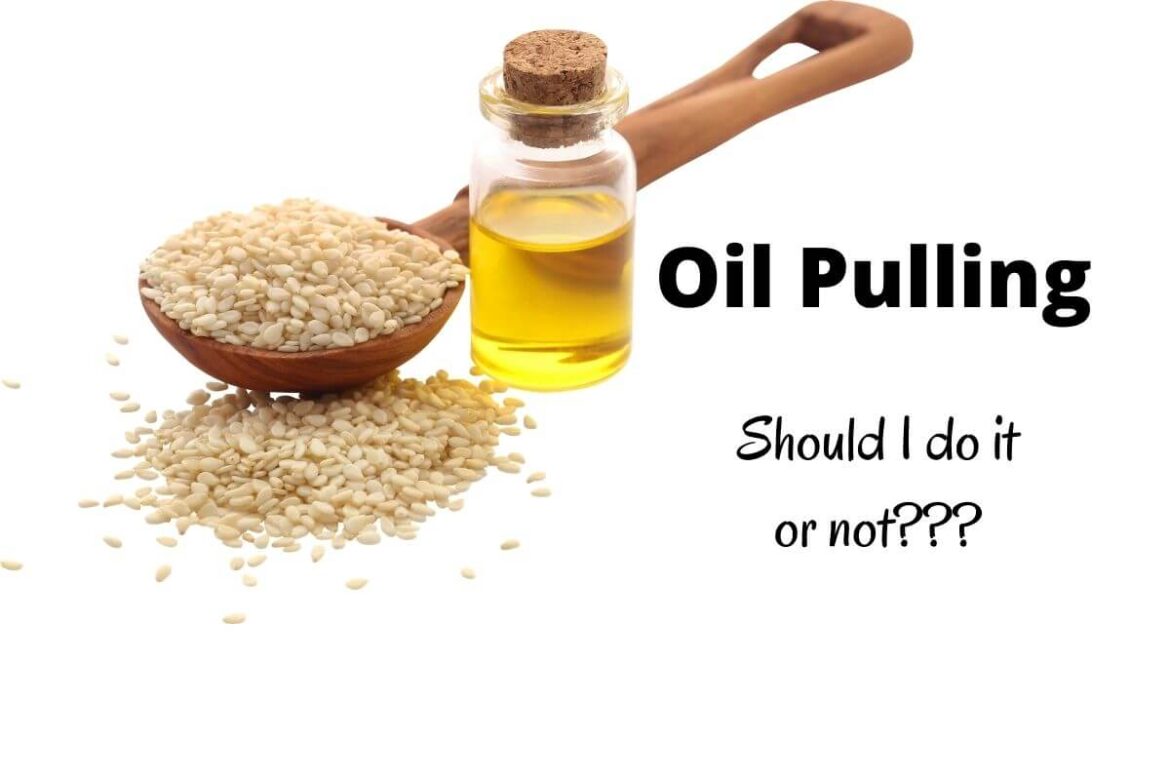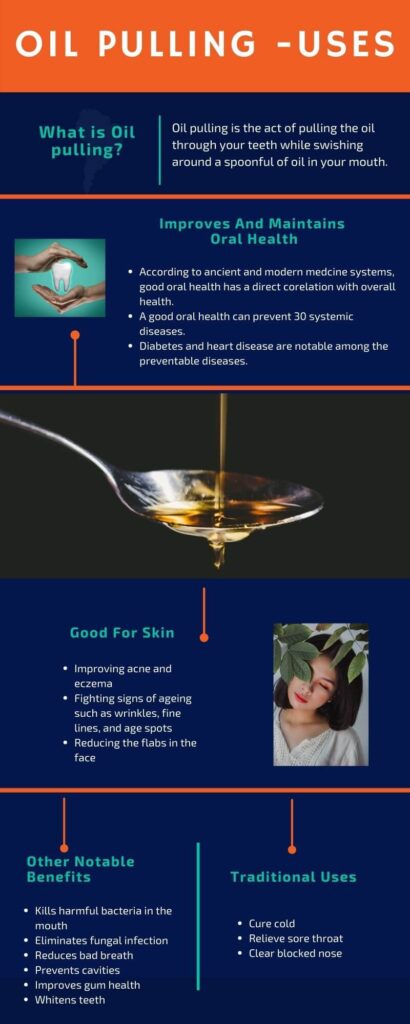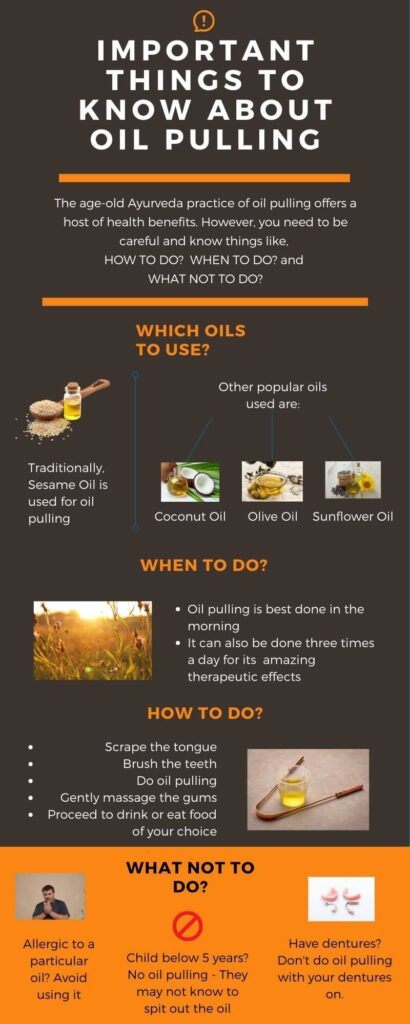We are sure you have heard about Oil pulling from your neighbour or a family member or on social media. And, you must have wondered if the hype about the several benefits the oil pulling practice claims to offer is real.
It is true, of course, and hence we have covered you the essential details about the practice.
Read on, and you will get to know what is oil pulling, how it works, the benefits it offers, how to oil pull and the precautions you must take.
Table of contents
First things first, What is oil pulling, and what does it do?
As the name implies, Oil pulling is the act of pulling the oil through your teeth while swishing around a spoonful of it in your mouth.
This simple technique helps remove toxins from the mouth.
While this method has drawn much interest during recent times, it is not so new. Instead, it is an age-old practice mentioned in the ancient Ayurveda texts!
Maintains Oral Health
The practice involves swishing around oil in your mouth for a considerable time and has a direct impact on improving and maintaining oral health.
Good oral health has a correlation to overall health both in modern and ancient medicine systems. For example, the prevention and treatment of dental caries and periodontal disease are known to reduce the risk of diabetes and heart disease.
Thus, doing it regularly and properly is believed to be helpful in treating over 30 of such systemic diseases.
And the oil pulling benefits does not end there!
Also Read:
Other Benefits
Apart from improving and maintaining your oral health, the other not-so-apparent health benefits derived from adopting the practice as a part of your routine are:
- Kills harmful bacteria in the mouth
- Eliminates fungal infection
- Reduces bad breath
- Prevents cavities
- Improves gum health
- Whitens teeth
Furthermore, since the process involves removing the toxins from the body, it serves as a natural way to detox your system, thereby improving the general immunity.
Also, traditionally pulling oil has been known for the following uses:
- Cure cold
- Relieve sore throat
- Clear blocked nose
Also Read: Preventive Dentistry – What You Need To Know?
You get beauty benefits too!
Interestingly, apart from health benefits, the practice offers beauty benefits as well. Make it a regular habit, and your skin is sure to glow!
Some of the prominent beauty benefits include,
- Improving acne and eczema
- Fighting signs of ageing such as wrinkles, fine lines, and age spot
- Reducing the flabs in the face
Also Read:
How To Oil Pull?
Now that your interest is piqued on the idea read and understand the steps below to try it out.
- Put a tablespoon full of oil in your mouth; make sure you do not swallow.
- Start swishing the oil around your mouth. Once you feel comfortable with the sensation, visualise pulling the oil between your teeth and try doing it.
- You can start by doing this for a couple of minutes initially.
- Once you get the hang of it, you can target to do up to 20 minutes, till the oil loses its texture and its colour turns milky white.
- Finally, spit out the contents of your mouth entirely and rinse well with warm water.
It is important to not swallow any of the oil while or after pulling the same as it contains all the toxins extracted from the mouth.
You can do this up to thrice a day if done for its therapeutic effects rather than general wellbeing.
Tip: Try to spit out the oil into the trash can rather than the washbasin or sink to avoid clogging the drain.
When Is The Right Time To Do It?
Ideally, you ought to pull oil in the morning, in an empty stomach. As per recommendations of Ayurveda Dinacharya on oral care routine, it is best to follow the steps below.
- Scrape the tongue
- Brush the teeth
- Pull oil
- Gently massage the gums
Then, you can proceed to drink water or any beverage of your choice or consume food after you complete the steps above, there is no need to brush again. In fact, Ayurveda literature advises that you don’t brush your teeth after doing it so that the oil acts as a protective barrier of your teeth.
Which Is The Best Oil for Oil Pulling?
Traditionally, sesame oil is used for this purpose. But coconut oil, olive oil and sunflower oil are some of the other oils popularly used for oil pulling. As each of those oils has its own set of merits, it boils down to availability and personal preference. So, you can try each one out and opt for the one that suits you the best.
Note: It is essential to use food-grade, possibly organic and cold-pressed oils without any additives such as preservatives to reap the maximum benefit.
Possible Side Effects
–> The American Dental Association (ADA) has reported the practice could potentially cause lipid pneumonia. This lung disease could happen if the oil is accidentally inhaled or swallowed in large quantities. And cases of diarrhoea or upset stomach have also been reported according to the ADA.
–> Similarly, if it is not done correctly, dry mouth, shortness of breath, excessive thirst, stiff muscle, fatigue, and loss of taste are found to be potential side effects.
Hence, it is essential to learn to do it correctly to avoid any such adverse impact.
Are there any safety considerations?
- If you are allergic to a particular oil, avoid it and use another one that is compatible with you.
- Specific contraindications to the practice are unknown. However, children below five years should avoid it, mostly because it will be hard to make sure they do not swallow some of the oil.
- And, for those with dentures, they should remove it before doing it.
The Takeaway
Though oil pulling benefits have been established, experts advise not to use it as a replacement to brushing and flossing for maintaining oral health. Instead, it will be an excellent add-on. You can also opt for herbal tooth powder or toothpaste for brushing if you wish to go all-natural!
Images from canva.com


